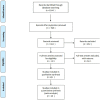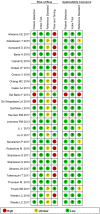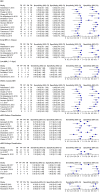Prognostic Value of Clinical Tests in Neonates With Hypoxic-Ischemic Encephalopathy Treated With Therapeutic Hypothermia: A Systematic Review and Meta-Analysis
- PMID: 32161566
- PMCID: PMC7052385
- DOI: 10.3389/fneur.2020.00133
Prognostic Value of Clinical Tests in Neonates With Hypoxic-Ischemic Encephalopathy Treated With Therapeutic Hypothermia: A Systematic Review and Meta-Analysis
Abstract
Background and Objective: There remains an unmet clinical need for markers that predict outcomes in the hypothermia-treated (HT) infants with HIE. The aim of this meta-analysis was to investigate the prognostic accuracy of currently available clinical tests performed in the immediate post-natal period for predicting neurological outcomes between 18 months and 3 years of age in HT near-term and term infants with perinatal asphyxia and HIE. Methods: A comprehensive review of the Embase, Cochrane library, and PubMed databases was performed to identify studies that evaluated the prognostic value of clinical tests for neurological outcomes in HT near-term and term infants with perinatal asphyxia and hypoxic-ischemic encephalopathy. Pooled sensitivity and specificity with corresponding 95% confidence intervals and area under the receiver operating characteristic (ROC) curve (AUC) were calculated. Results: Of the 1,144 relevant studies, 26 studies describing four clinical tests conducted in 1458 HT near-term or term infants were included. For predicting an unfavorable neurological outcome, of the imaging techniques, MRI within 2 weeks of birth performed best on sensitivity 0.85 (95% CI 0.79-0.89), specificity 0.72 (95% CI 0.66-0.77), and AUC 0.88; among the neurophysiological tests, multichannel EEG (Electroencephalogram) demonstrated the sensitivity 0.63 (95% CI 0.49-0.76), specificity 0.82 (95% CI 0.70-0.91), and AUC 0.88, and for aEEG (amplitude-integrated electroencephalography) background pattern pooled sensitivity, specificity and AUC were 0.90 (95% CI 0.86-0.94), 0.46 (95% CI 0.42-0.51), and 0.78 whereas for SEPs (Somatosensory evoked potentials), pooled sensitivity and specificity were 0.52 (95% CI 0.34-0.69), 0.76 (95% CI 0.63-0.87), and AUC 0.84, respectively. Conclusions: In the wake of the era of TH, MRI and neurophysiological tests (aEEG or EEG) were promising predictors of adverse outcomes, while SEPs need high-quality studies to confirm the findings. Continued follow-up of the children and well-designed large prospective studies are essential to determine whether these benefits are maintained in later childhood.
Keywords: clinical test; hypoxic-ischemic encephalopathy; neonates; prognosis; therapeutic hypothermia.
Copyright © 2020 Liu, Yang, Wei, Dong, Fan and Hua.
Figures




Similar articles
-
[Meta-analysis of prognostic tests in neonates over 35-week gestational age with hypoxic-ischemic encephalopathy].Zhonghua Yi Xue Za Zhi. 2014 Jan 14;94(2):115-21. Zhonghua Yi Xue Za Zhi. 2014. PMID: 24721351 Chinese.
-
Prognostic Value of Electroencephalography in Hypothermia-Treated Neonates With Hypoxic-Ischemic Encephalopathy: A Meta-Analysis.Pediatr Neurol. 2019 Apr;93:3-10. doi: 10.1016/j.pediatrneurol.2018.12.013. Epub 2018 Dec 28. Pediatr Neurol. 2019. PMID: 30691779
-
Prediction of Outcome in Neonates with Hypoxic-Ischemic Encephalopathy II: Role of Amplitude-Integrated Electroencephalography and Cerebral Oxygen Saturation Measured by Near-Infrared Spectroscopy.Neonatology. 2017;112(3):193-202. doi: 10.1159/000468976. Epub 2017 Jul 14. Neonatology. 2017. PMID: 28704822 Clinical Trial.
-
Mild Hypoxic-Ischemic Encephalopathy: Can Neurophysiological Monitoring Predict Unfavorable Neurological Outcome? A Systematic Review and Meta-analysis.Am J Perinatol. 2023 Jun;40(8):833-838. doi: 10.1055/s-0041-1736593. Epub 2021 Oct 19. Am J Perinatol. 2023. PMID: 34666398
-
A Systematic Review of EEG and MRI Features for Predicting Long-Term Neurological Outcomes in Cooled Neonates With Hypoxic-Ischemic Encephalopathy (HIE).Cureus. 2024 Oct 14;16(10):e71431. doi: 10.7759/cureus.71431. eCollection 2024 Oct. Cureus. 2024. PMID: 39539899 Free PMC article. Review.
Cited by
-
Neuroprotection for hypoxic-ischemic encephalopathy: Contributions from the neonatal research network.Semin Perinatol. 2022 Nov;46(7):151639. doi: 10.1016/j.semperi.2022.151639. Epub 2022 Jun 10. Semin Perinatol. 2022. PMID: 35835616 Free PMC article. Review.
-
Neuroprognostication in neonatal encephalopathy due to presumed hypoxic-ischemic encephalopathy.Pediatr Res. 2025 Apr 6. doi: 10.1038/s41390-025-04058-1. Online ahead of print. Pediatr Res. 2025. PMID: 40188218 Review.
-
Alzheimer's Disease Associated Presenilin 1 and 2 Genes Dysregulation in Neonatal Lymphocytes Following Perinatal Asphyxia.Int J Mol Sci. 2021 May 13;22(10):5140. doi: 10.3390/ijms22105140. Int J Mol Sci. 2021. PMID: 34067945 Free PMC article.
-
Optimal neuromonitoring techniques in neonates with hypoxic ischemic encephalopathy.Front Pediatr. 2023 Mar 8;11:1138062. doi: 10.3389/fped.2023.1138062. eCollection 2023. Front Pediatr. 2023. PMID: 36969281 Free PMC article. Review.
-
Thermal Index for early non-invasive assessment of brain injury in newborns treated with therapeutic hypothermia: preliminary report.Sci Rep. 2021 Jun 15;11(1):12578. doi: 10.1038/s41598-021-92139-6. Sci Rep. 2021. PMID: 34131269 Free PMC article.
References
-
- Rutherford M, Ramenghi LA, Edwards AD, Brocklehurst P, Halliday H, Levene M, et al. . Assessment of brain tissue injury after moderate hypothermia in neonates with hypoxic-ischaemic encephalopathy: a nested substudy of a randomised controlled trial. Lancet Neurol. (2010) 9:39–45. 10.1016/S1474-4422(09)70295-9 - DOI - PMC - PubMed
Publication types
LinkOut - more resources
Full Text Sources

